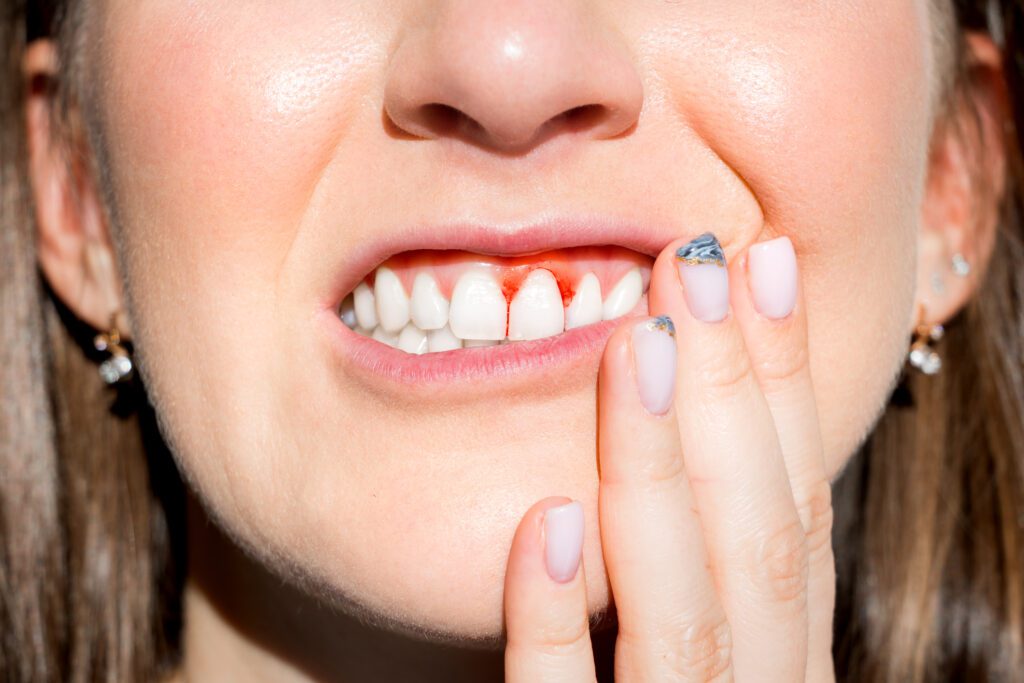Gum disease, also known as periodontal disease, is a common dental problem that affects the health of your gums and the bone that supports your teeth. If left untreated, gum disease can lead to tooth loss and other serious health issues. We provide comprehensive periodontal disease treatment in Garland, TX, to help you maintain a healthy smile.
Whether you’re already experiencing symptoms of gum disease or want to learn how to prevent it, we’re here to help. Gum disease treatment is part of restorative dentistry. We can renew the comfort and health of your gums at Cornerstone Family Dentistry.

What is Gum Disease?
Gum disease is an infection of the tissues surrounding your teeth. It occurs when plaque, a sticky film of bacteria, builds up on your teeth and gums. If plaque is not removed through proper brushing and flossing, it can harden into tartar, which can only be removed by a dentist.
Tartar and plaque irritate the gums, causing inflammation and infection. This infection can harm the gums and even the bone that holds your teeth in place. Early detection and treatment of gum disease can help prevent long-term damage to your smile.
Signs of Gum Disease
Knowing the signs of gum disease can help you catch it early and seek treatment before it worsens. Some of the most common signs of gum disease include:
- Red or swollen gums
- Red or purple gums
- Bleeding gums
- Bad breath (even after you brush)
- Gum recession
- Loose teeth
- Pain when chewing
If you notice any of these symptoms, schedule a dental appointment right away. Our Garland dental team can assess your gums and determine the best action to restore your oral health. We provide periodontal disease treatment in our Garland, TX, office to restore the look, function, and comfort of your teeth and gums.
Gingivitis
Gum inflammation, or gingivitis, is the earliest stage of gum disease. It occurs when plaque buildup causes your gums to become inflamed. At this stage, the damage is reversible, and with proper dental care and good oral hygiene, you can restore your gums to health.
Signs of gingivitis include red, swollen gums that may bleed when you brush. You may not experience much discomfort, but taking these signs seriously is essential. If left untreated, gum inflammation can progress into a more severe form of gum disease.
Periodontitis
The advanced stage of gum disease is periodontitis. In this stage, the infection has spread to the bone and tissue supporting your teeth. The gums may pull away from the teeth, forming pockets that collect bacteria and food particles. As the disease progresses, it can lead to bone loss, loose teeth, and eventually tooth loss.
Periodontitis requires professional treatment to prevent further damage. While the effects of gum disease can’t be fully reversed, treatment can help stop it from progressing.
Periodontal Disease Treatment in Garland, TX
At our Garland dental office, we offer a range of treatments to help manage and treat gum disease. The type of treatment you need will depend on the severity of your condition.
Scaling and Root Planing
Also known as deep cleaning, this is one of the most common treatments for gum disease. During scaling, we remove plaque and tartar from the surface of your teeth and below the gumline. Root planing involves smoothing the roots of your teeth to prevent bacteria from collecting and to help your gums reattach to your teeth.
This procedure is typically done under local anesthesia to ensure your comfort. It may take more than one visit, depending on the extent of the gum disease.
Antibiotic Therapy
In some cases, we may recommend antibiotic therapy in conjunction with scaling and root planing. Antibiotics can be applied directly to the infected gum pockets to kill bacteria and reduce inflammation. This helps promote healing and prevent the disease from spreading.
Surgical Treatments
In severe cases of gum disease, surgery may be necessary. This could involve flap surgery, where the gums are lifted to remove tartar, or a bone graft to restore the bone that has been lost due to gum disease. Our goal is always to restore as much of your gum and bone structure as possible, helping to save your teeth and prevent further damage. We will refer you to a specialist for surgery.
How to Prevent Gum Disease
Prevention is the best way to protect your gums from disease. Here are some steps you can take to keep your gums healthy:
Brush Twice a Day
Brushing your teeth twice a day is one of the simplest and most effective ways to protect your gums. Use a soft-bristled toothbrush and fluoride toothpaste. Make sure to brush for at least two minutes each time.
Pay special attention to the gum line, where plaque and bacteria can build up. Plaque is a sticky film that can lead to gum disease if not removed. Brushing regularly helps keep your gums clean and healthy.
Floss Daily
Flossing is just as important as brushing. While your toothbrush cleans the surfaces of your teeth, floss helps remove plaque and food particles stuck between your teeth that your brush can’t reach. Make it a habit to floss every day, especially before bedtime.
Be gentle when you floss to avoid hurting your gums. If you notice any bleeding while flossing, don’t worry too much, but mention it to our dentist at your next visit.
Use Mouthwash
Incorporating an antibacterial mouthwash into your daily routine can provide extra protection for your gums. Mouthwash helps reduce plaque and bacteria in your mouth, giving your gums an additional layer of defense. Look for a mouthwash that specifically mentions it helps with gum health.
Use it as directed, and remember that it’s not a substitute for brushing and flossing. Mouthwash is just an extra step to keep your mouth clean.
Make Regular Dental Visits
Scheduling regular dental check-ups and cleanings is crucial for your oral health. Aim to visit your dentist every six months. During these visits, your dental team will perform professional cleanings to remove tartar buildup, which can’t be removed by brushing alone. They will also monitor your gum health and check for any signs of gum disease. Early detection is key, and our dentist can guide you on improving your oral hygiene routine.
Quit Smoking
If you smoke, quitting can have a huge impact on your gum health. Smoking weakens your immune system, making it harder for your gums to heal. It can also increase your risk of developing gum disease.
By quitting smoking, you can improve your oral health and reduce the chances of serious dental problems. If you need help quitting, many resources are available, including support groups and programs that can assist you.
Eat a Balanced Diet
What you eat plays a big role in your gum health. A balanced diet rich in vitamins and nutrients supports healthy gums and teeth. Focus on foods high in vitamin C, such as oranges, strawberries, and leafy greens.
Vitamin C helps keep your gums strong and can even aid in healing. Calcium-rich foods, like dairy products and leafy greens, are also essential for strong teeth and bones. Eating a variety of healthy foods can help you maintain good gum health.
Get Healthy Gums
If you have signs of gum disease, don’t wait to seek treatment. We’re here to help you manage and treat gum disease so you can maintain a healthy smile with periodontal disease treatment in Garland, TX. Call Cornerstone Family Dentistry at 972-848-7749 or request an appointment online.
